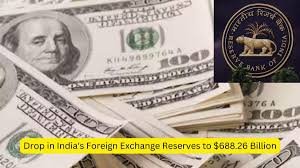Drop in India’s Foreign Exchange Reserves to $688.26 Billion
India’s foreign exchange reserves have witnessed a notable decline, now standing at $688.26 billion as of October 20, 2023. This decrease, amounting to $4.84 billion, is a significant concern for the Indian economy, as these reserves play a crucial role in maintaining the country’s financial stability and ability to meet its international obligations.
Current Status of Foreign Exchange Reserves
The recent figures from the Reserve Bank of India (RBI) reveal that the drop is primarily due to the decline in foreign currency assets, which decreased by $5.23 billion to $613.03 billion. Foreign currency assets constitute the largest component of the total reserves. The decline has raised alarms among economists and policymakers about the potential implications for the Indian rupee and the overall economic stability.
Factors Contributing to the Decline
Several factors have contributed to this decline in reserves. Global market volatility, fluctuating oil prices, and changes in the monetary policies of major economies are key contributors. The strengthening of the US dollar against other currencies has also had a detrimental impact on the value of India’s foreign currency assets.
Implications for the Indian Economy
A drop in foreign exchange reserves can have several implications for the Indian economy. It may lead to increased volatility in the forex market, affecting the value of the Indian rupee against foreign currencies. Moreover, a lower reserve level could hamper the RBI’s ability to intervene in the currency market effectively, raising concerns among investors regarding the country’s economic health.
Government and RBI’s Response
In response to the declining reserves, the Indian government and the RBI are closely monitoring the situation. Strategies may be implemented to bolster foreign exchange reserves, including attracting foreign direct investment and improving the trade balance. The government remains committed to ensuring economic stability and growth amidst these challenges.

Why This News is Important
Impact on the Indian Economy
The decrease in India’s foreign exchange reserves is crucial for several reasons. Foreign exchange reserves serve as a safety net for a country’s economy, helping to maintain the stability of the national currency and ensuring that the country can meet its international obligations. A significant drop in these reserves can lead to currency depreciation, making imports more expensive and potentially triggering inflation.
Investor Confidence
For investors, the level of foreign exchange reserves is often an indicator of a country’s financial health. A decline in reserves can shake investor confidence, leading to capital flight and reduced foreign investment. This can further exacerbate economic challenges and lead to slower economic growth.
Monetary Policy Implications
The Reserve Bank of India (RBI) uses foreign exchange reserves to implement monetary policy. A decrease in these reserves can limit the RBI’s ability to manage liquidity in the economy effectively, which may affect interest rates and overall economic activity.
Long-term Economic Stability
Long-term economic stability depends on maintaining adequate foreign exchange reserves. A significant and sustained decline may pose risks to India’s economic growth and development, impacting various sectors, including trade, investment, and employment.
Historical Context
Trends in Foreign Exchange Reserves
India’s foreign exchange reserves have experienced fluctuations over the years, influenced by global economic conditions and domestic factors. Following the 1991 economic crisis, India adopted measures to strengthen its forex reserves, including liberalizing the economy and attracting foreign investment. Over the years, reserves have generally increased, peaking in recent years, driven by robust capital inflows and a favorable trade balance.
Recent Economic Developments
In recent years, India has faced various challenges, including rising global oil prices, geopolitical tensions, and the impact of the COVID-19 pandemic on the economy. These factors have impacted trade balances and capital flows, contributing to the current decline in reserves.
Key Takeaways from “Drop in India’s Foreign Exchange Reserves”
| Serial Number | Key Takeaway |
|---|---|
| 1 | India’s foreign exchange reserves have dropped to $688.26 billion. |
| 2 | The decline of $4.84 billion is attributed mainly to foreign currency assets decreasing by $5.23 billion. |
| 3 | Global market volatility and strengthening of the US dollar are major contributing factors. |
| 4 | A drop in reserves may lead to increased volatility in the forex market and affect the rupee’s value. |
| 5 | The government and RBI are monitoring the situation and may implement strategies to bolster reserves. |
Important FAQs for Students from this News
1. What are foreign exchange reserves?
Foreign exchange reserves are assets held by a central bank in foreign currencies. They are used to back liabilities and influence monetary policy. These reserves include foreign currencies, gold, and Special Drawing Rights (SDRs) from the International Monetary Fund (IMF).
2. Why are foreign exchange reserves important for a country?
Foreign exchange reserves are crucial for maintaining the stability of a country’s currency, managing exchange rate volatility, and ensuring that the country can meet its international payment obligations. They provide a buffer against external shocks and economic crises.
3. How does a decline in foreign exchange reserves affect the economy?
A decline can lead to a weaker national currency, increased inflation, and reduced investor confidence. It can also limit the central bank’s ability to intervene in foreign exchange markets to stabilize the currency.
4. What factors can lead to a drop in foreign exchange reserves?
Factors include global economic volatility, changes in oil prices, shifts in trade balances, capital outflows, and fluctuations in foreign investment. Additionally, interventions by the central bank to stabilize the currency can also deplete reserves.
5. How can India improve its foreign exchange reserves?
India can enhance its foreign exchange reserves by attracting more foreign direct investment (FDI), improving the trade balance by boosting exports, and adopting sound fiscal and monetary policies that instill confidence among investors.
Some Important Current Affairs Links


















 Exciting News!
Exciting News!  Join Our Telegram Channel Now!
Join Our Telegram Channel Now!
 Join our Telegram channel for a thrilling adventure into the world of daily current affairs.
Join our Telegram channel for a thrilling adventure into the world of daily current affairs. 
 Don’t miss out on the latest updates and insights! Click to join now and be part of the knowledge revolution!
Don’t miss out on the latest updates and insights! Click to join now and be part of the knowledge revolution! 
